| Pages:
1
..
17
18
19
20
21
..
60 |
jgourlay
Hazard to Others
  
Posts: 249
Registered: 9-7-2008
Member Is Offline
Mood: No Mood
|
|
Wow...this thread is a LOT to absorb. From what I've read so far, it appears this thread has a global contributorship. For this reason, I'd
appreciate if you all would indulge me in one clarifying question.
IN THE UNITED STATES, what are the readily available sources of raw material for one of the proven methods detailed in the thread? For example, I
read "calgon tablets" but then also "have none depending on where you are".
|
|
|
Magpie
lab constructor
    
Posts: 5939
Registered: 1-11-2003
Location: USA
Member Is Offline
Mood: Chemistry: the subtle science.
|
|
Today I made a small amount of P according to the following reaction:
6NaPO3 + 10Al + 3SiO2 --> 3Na2SiO3 + 5Al2O3 + 6P
Stoichiometric ratios of the reactants were mixed in a mortar. The Al was 100-200 mesh, the SiO2 200 mesh pottery grade, and the NaPO3 was technical
grade. My basis was 5g of P.
I have been wanting to try this for some time but have not been able to find a suitable luting compound to join a ceramic retort to a glass adaptor.
I finally settled upon the best candidate that would give me a truly positive seal, yet was releaseable following the experiment. This is Permatex
high temperature RTV silicone. Previous testing with a ceramic tile/glass slide showed that an RTV seal can be destroyed in about 2 hours with con
sulfuric acid at 125C, thereby allowing recovery of the glass piece.
After loading the retort the 24/40 glass adapter was attached using the RTV and allowed to cure overnight. Today the retort was backfilled with
argon, placed in a tube furnace, and a 400 mL beaker of water located to provide a water seal for the adaptor outlet.
Over a period of 3 hours the temperature of the furnace was brought up to a maximum of 1300C. Most of the time there was just a periodic large bubble
evolved indicating expansion of the gas in the retort. However, at times the bubbling would stop, be erratic, or even form a vacuum of about 1/2"
water. During the last 100C or so it seemed like no gas was formed, or any vacuum either.
P never did drop into the receiver as I had intended. When I removed the insulation from the adaptor I found a small pool of solidified P, tainted
red from the RTV. Using a bunsen burner I melted the P, picked up the furnace and drained the 4 or 5 drops of waxy, heavy P into the receiver.
In an attempt to scavenge the remaining P I removed the hot retort from the furnace and tried to drain any P into the receiver. Even with heating
from a bunsen burner no more was obtained. My overzealous use of the bunsen burner resulted in cracking of the glass adaptor.
One of the drops of P was placed in a small crucible and lit with a match. It burned vigorously. I was slow to get my camera but you can see the
last of it burning in one of the pictures.
I'm still curious about the rest of the P. So when I figure out a good place to do it I will open up the retort with a pair of channel locks and
report back.
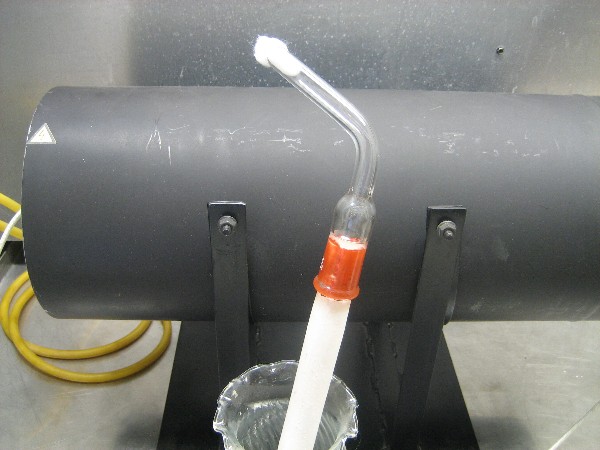 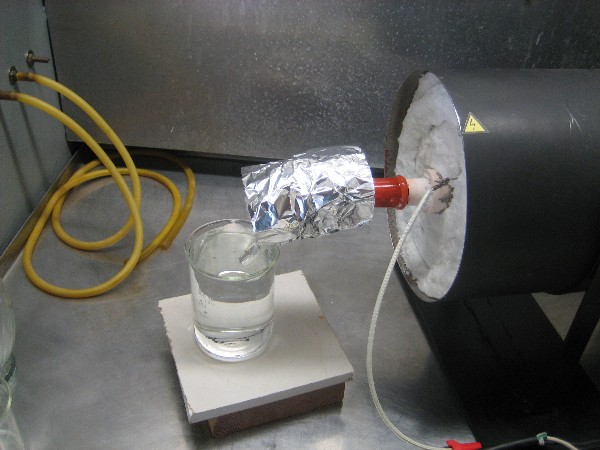 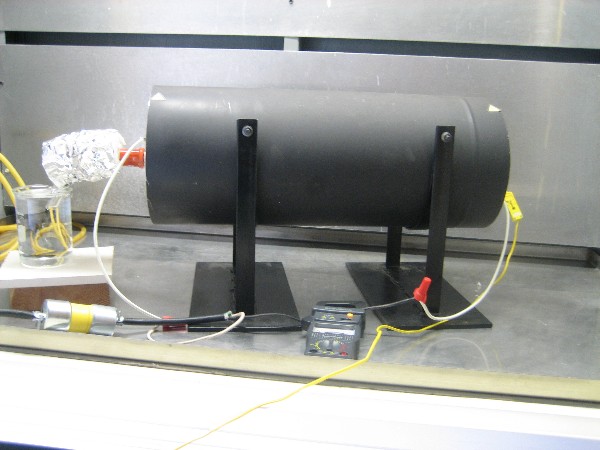 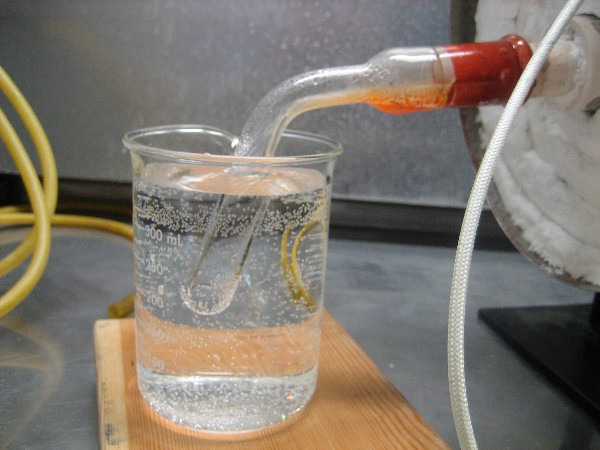 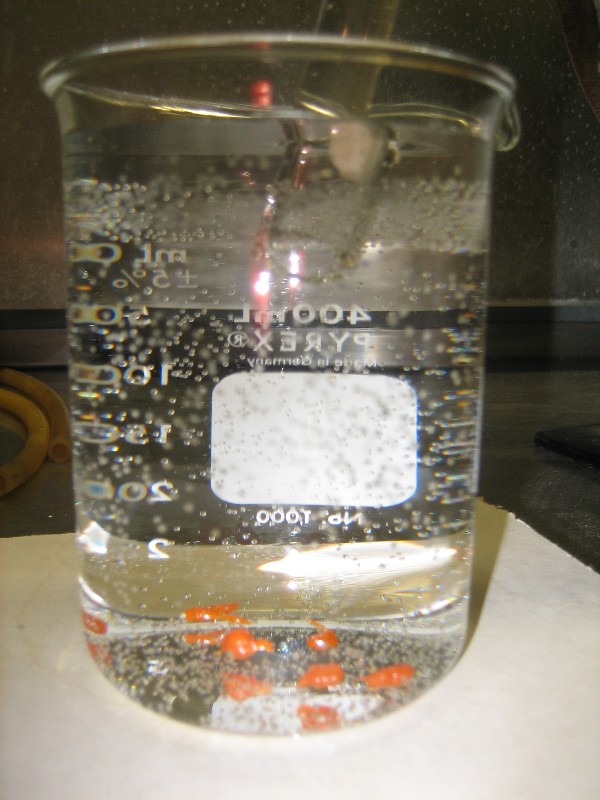 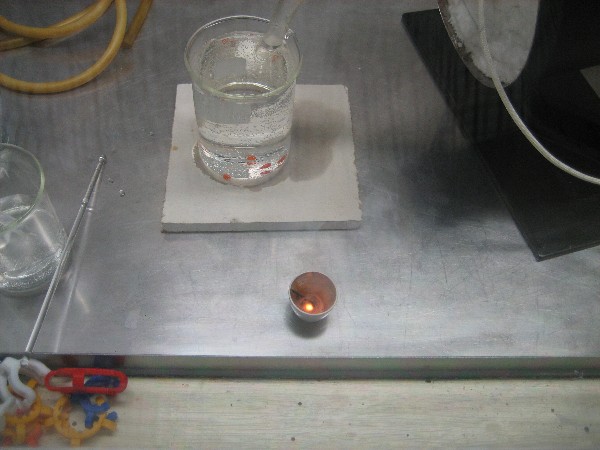 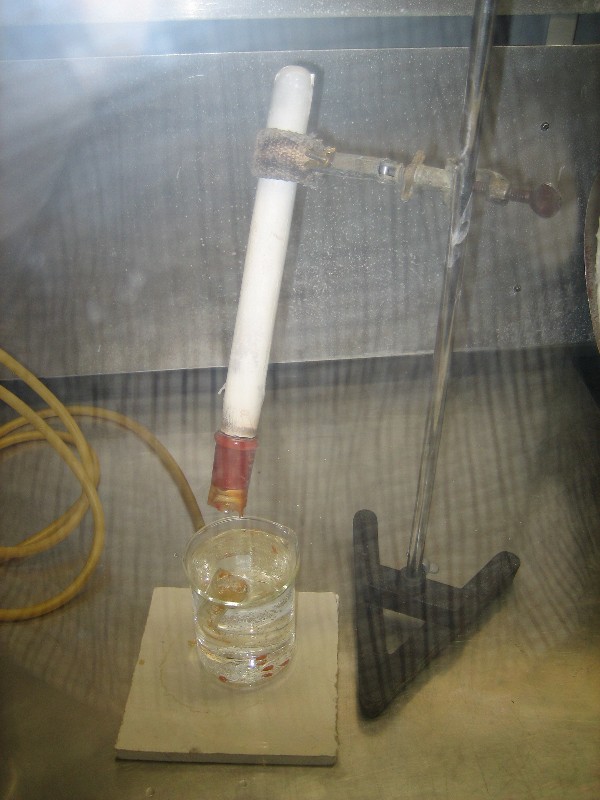
[Edited on 6-3-2010 by Magpie]
The single most important condition for a successful synthesis is good mixing - Nicodem
|
|
|
Jor
National Hazard
   
Posts: 950
Registered: 21-11-2007
Member Is Offline
Mood: No Mood
|
|
Nice work! What are you going to use the P for? PCl3, PCl5 or anything else?
How expensive was the broken piece of glassware?
|
|
|
Magpie
lab constructor
    
Posts: 5939
Registered: 1-11-2003
Location: USA
Member Is Offline
Mood: Chemistry: the subtle science.
|
|
Quote: Originally posted by Jor  | Nice work! What are you going to use the P for? PCl3, PCl5 or anything else?
How expensive was the broken piece of glassware? |
I would like to make some PCl3 and PCl5. But I'll need to collect a larger quantity first. And to do that I've got some bugs to work out.
The glass adaptor was $21 including shipping. I won't make that stupid mistake again.
The single most important condition for a successful synthesis is good mixing - Nicodem
|
|
|
blogfast25
International Hazard
    
Posts: 10562
Registered: 3-2-2008
Location: Neverland
Member Is Offline
Mood: No Mood
|
|
Interesting run. I'm surprised you didn't get more phosphorus: my own, much simpler experiment
http://www.sciencemadness.org/talk/viewthread.php?tid=65&...
seemed to indicate that once you get ignition the reaction becomes self-sustaining because of the reaction heat.
In your experiment, most of the phosphorus must have condensed in a cooler part...
But why use a ceramic retort, which by now will be rendered useless by the slag: a mixture of alumina and sodium silicate?
I'd suggest a steel tube of similar dimensions and capped off with a threaded cap or welded shut. Heat with Bunsen or propane flame torch. A higher
charge would also help: 5 g of phosphorus isn't much...
|
|
|
Magpie
lab constructor
    
Posts: 5939
Registered: 1-11-2003
Location: USA
Member Is Offline
Mood: Chemistry: the subtle science.
|
|
Quote: Originally posted by blogfast25  | Interesting run. I'm surprised you didn't get more phosphorus: my own, much simpler experiment
http://www.sciencemadness.org/talk/viewthread.php?tid=65&...
seemed to indicate that once you get ignition the reaction becomes self-sustaining because of the reaction heat.
In your experiment, most of the phosphorus must have condensed in a cooler part...
But why use a ceramic retort, which by now will be rendered useless by the slag: a mixture of alumina and sodium silicate?
I'd suggest a steel tube of similar dimensions and capped off with a threaded cap or welded shut. Heat with Bunsen or propane flame torch. A higher
charge would also help: 5 g of phosphorus isn't much...
|
>I'm in the process of learning just how high I have to take the heat to get a decent yield - likely not the full 1300C capability of my furnace.
> The cooler part was essentially the glass adaptor. When it broke off some phosphorus did ignite near the top of the retort. When I open it up
today I'll know if there is anymore inside. I doubt if there is as I think I would have seen it burning.
> Yes, the ceramic tube is now worthless - it is intended to be sacrificial. They cost very little in materials to make but do take some time.
Have you seen how much heat is required to use a steel tube? If not, see the work of Gruson, this forum.
> Yes, 5g is small. This was my first attempt.
The single most important condition for a successful synthesis is good mixing - Nicodem
|
|
|
blogfast25
International Hazard
    
Posts: 10562
Registered: 3-2-2008
Location: Neverland
Member Is Offline
Mood: No Mood
|
|
@ Magpie:
In my case, the reaction started well before my 25 ml SS 'crucible' (a measure for liquor shots, actually) started to actually glow. By the end of the
reaction (10 g total charge) the whole thing, crucible included, was glowing a bright red-orange...
How about a copper (cooking gas) tube? 1 inch diameter, fairly thin walled (about 1 mm I'd say), quite cheap, conducts heat like mad...
|
|
|
Strepta
Harmless

Posts: 44
Registered: 6-5-2004
Member Is Offline
Mood: No Mood
|
|
@Magpie-- Nice work as usual! Was your ceramic retort made of alumina? You may have success trying to clean it with HCl. That worked well for me when
cleaning pyrex or quartz after a calgon reduction with Al. Fill it about half full with HCl and close the ends with neoprene stoppers and let stand
for an hour or so. Then remove the slag with a suitable wooden dowel rod. The glass always recovered nicely, but of course I wasn't taking the
reaction temp to 1300 C!
On a different note, at some point in the future you may want to try boron oxide in place of SiO2. I got my best yield of P (52%) using B2O3, although
it's not a huge improvement over SiO2. Good luck and keep those pictures coming!
|
|
|
Magpie
lab constructor
    
Posts: 5939
Registered: 1-11-2003
Location: USA
Member Is Offline
Mood: Chemistry: the subtle science.
|
|
The retort was made of about 2/3's mullite and 1/3 feldspathic to vitrify to 0% porosity. Also, thanks for your suggestions.
I just finished cutting open the retort. I decided to use a Dremel diamond cutoff wheel so that the content integrity could be better maintained. I
made two cuts.
The exit end of the retort was virtually plugged with a somewhat foamy grey slag. The slag front was coated with a red powder. I don't know what
this could be other than red P. Is that possible?
Because this slag is so voluminous this may not be the best approach for making P. I will be trying other reactants eventually.
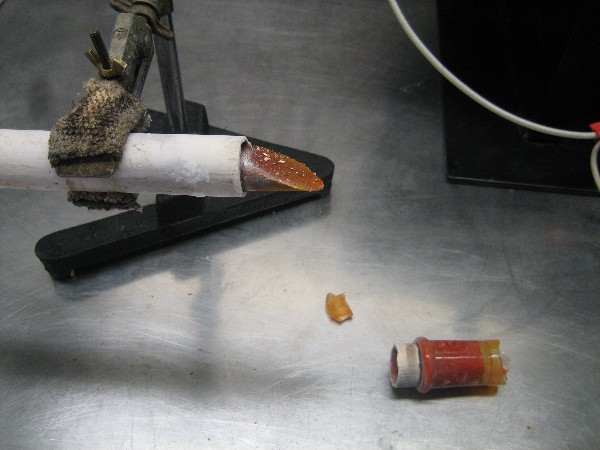 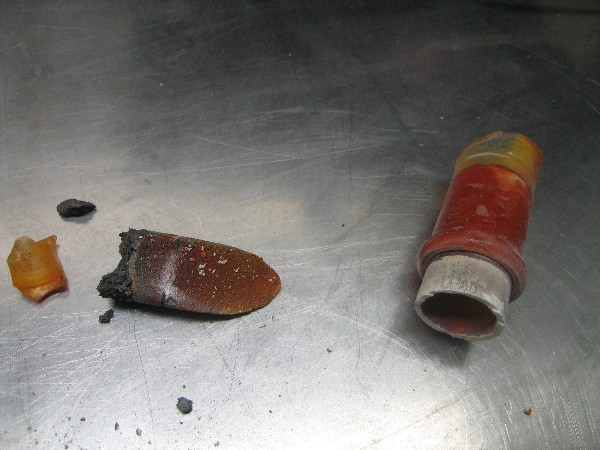 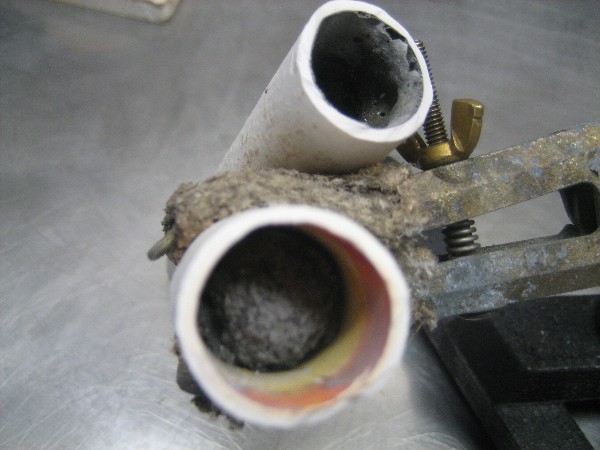
The single most important condition for a successful synthesis is good mixing - Nicodem
|
|
|
blogfast25
International Hazard
    
Posts: 10562
Registered: 3-2-2008
Location: Neverland
Member Is Offline
Mood: No Mood
|
|
@ Magpie:
Surely that must be impure Red P. Surely you will test it?
The slag resembles what I obtained. I doubt if other reactants would make much difference: your gaseous P has to evade from a half molten/half
sintered mass of silicate/alumina. No wonder it 'puffs up'! I saw that happening in my crucible...
A higher temperature at the end and slightly longer charge and the P would possibly have come gushing out.
Bear also in mind that due to mechanical entrainment, your P will still need purifying: sublimation, I'm guessing...
[Edited on 6-3-2010 by blogfast25]
|
|
|
DJF90
International Hazard
    
Posts: 2266
Registered: 15-12-2007
Location: At the bench
Member Is Offline
Mood: No Mood
|
|
Blogfast25: From your reasoning it would be sensible not to pack the tube, but to have an air space above the reaction mass when the tube is in the
horizontal position. Using a packed tube seems kinda illogical in the first place but perhaps that's just my personal view.
|
|
|
blogfast25
International Hazard
    
Posts: 10562
Registered: 3-2-2008
Location: Neverland
Member Is Offline
Mood: No Mood
|
|
Quote: Originally posted by DJF90  | | Blogfast25: From your reasoning it would be sensible not to pack the tube, but to have an air space above the reaction mass when the tube is in the
horizontal position. Using a packed tube seems kinda illogical in the first place but perhaps that's just my personal view. |
@ DJF90:
Yes, something like that: where you have reaction the P cannot condense (too hot) but it does condense easily where it's a little cooler, as both
Strepta's test tube as well as Magpies's run clearly show. A packed tube is probably not advisable: that will block the path of the evolving
phosphorus gas...
Well observed...
|
|
|
Magpie
lab constructor
    
Posts: 5939
Registered: 1-11-2003
Location: USA
Member Is Offline
Mood: Chemistry: the subtle science.
|
|
I might add that a full retort (up to the taper) would require 77mL of reactants. For 5g of P the charge volume was 25mL. Before placing the retort
in the furnace I tapped the tube to level the charge with a slight bias toward the closed end. Of course the end result is just a guess.
The single most important condition for a successful synthesis is good mixing - Nicodem
|
|
|
len1
National Hazard
   
Posts: 595
Registered: 1-3-2007
Member Is Offline
Mood: NZ 1 (goal) - Italy 1 (dive)
|
|
Nice work! But I must agree with blfst25 that steel is a more convenient material in this reaction. It gives you more even heat distribution, and
you can control heat of your receptacle tube with water cooling, that way you wont get clogging. Excessive heat consumption only occurs if you expose
much un-insulated metal surface outside the furnace. Back when I was still doing home experiments and my practical guides I was going to this, but
phosphorus unfortunately has a bad press, so I never did.
|
|
|
Panache
International Hazard
    
Posts: 1290
Registered: 18-10-2007
Member Is Offline
Mood: Instead of being my deliverance, she had a resemblance to a Kat named Frankenstein
|
|
Consider pressing small tablets out of your starting reagents using a kbr die used to press IR plates, (however make the tablet thicker than you would
a KBr plate), this would seem like a suitable way to overcome your volume issues, as the tabletted form can be more easily dispersed.
As for retort materials, have you considered tupperware, if you're interested perhaps you would like to host a party. There are great benefits to
hosting!!
|
|
|
Magpie
lab constructor
    
Posts: 5939
Registered: 1-11-2003
Location: USA
Member Is Offline
Mood: Chemistry: the subtle science.
|
|
Quote: Originally posted by Panache  | Consider pressing small tablets out of your starting reagents using a kbr die used to press IR plates, (however make the tablet thicker than you would
a KBr plate), this would seem like a suitable way to overcome your volume issues, as the tabletted form can be more easily dispersed.
As for retort materials, have you considered tupperware, if you're interested perhaps you would like to host a party. There are great benefits to
hosting!! |
I'm not sure what the tableting, or briqueting, would accomplish other than facilitating the passage of gaseous P. I know this has been done on a
commercial scale, for that reason I believe.
I have considered Tupperware. But there is a small seal on this product and I have made a pledge that no animals will be harmed in my experiments.
The single most important condition for a successful synthesis is good mixing - Nicodem
|
|
|
entropy51
Gone, but not forgotten
    
Posts: 1612
Registered: 30-5-2009
Member Is Offline
Mood: Fissile
|
|
An experiment along these lines is described on page 74 of the July 1938 Popular Science.
|
|
|
Magpie
lab constructor
    
Posts: 5939
Registered: 1-11-2003
Location: USA
Member Is Offline
Mood: Chemistry: the subtle science.
|
|
Very interesting. Thanks for posting this!
It seems like all home chemists wore ties in the old days. I suppose it gives the aura of competence. I also like the references to being able to
easily obtain the needed chemicals, like hypophosphite, at most any old chemical distributor.
These home chemistry articles always seem so casual about it all. At least here they recognize phosphorus as "treacherous."
The single most important condition for a successful synthesis is good mixing - Nicodem
|
|
|
len1
National Hazard
   
Posts: 595
Registered: 1-3-2007
Member Is Offline
Mood: NZ 1 (goal) - Italy 1 (dive)
|
|
A beautiful demonstration of how people have lost their marbles since those days.
Now if you submitted a way to make P to an amateur magazine they'll
1) Start screaming OHS, wheras in fact people care about each other not one iota more than in those days
2) Say you are encouraging terrorism and drug making
3) People are not so "naive" to bother to do work just for fascination in science.
[Edited on 9-3-2010 by len1]
|
|
|
Taoiseach
Hazard to Others
  
Posts: 241
Registered: 16-3-2008
Member Is Offline
Mood: No Mood
|
|
Quote: Originally posted by Magpie  | | It seems like all home chemists wore ties in the old days. I suppose it gives the aura of competence |
His index finger looks as if he used to fiddle with even more dangerous compounds than P tough 
[Edited on 10-3-2010 by Taoiseach]
|
|
|
entropy51
Gone, but not forgotten
    
Posts: 1612
Registered: 30-5-2009
Member Is Offline
Mood: Fissile
|
|
Quote: Originally posted by Magpie  |
It seems like all home chemists wore ties in the old days. I suppose it gives the aura of competence. |
That
was just the city boys. If you find the March 1939 Popular Science on Google Books, on page 206 the chemist is a farm boy making acetamide. He is
dressed accordingly in what we used to call "bib overalls", but I suppose some call coveralls.
If you go to the link I posted and enter "Wailes" in the search box and check "search all issues" you will find all the other home chemistry articles
by Raymond Wailes. Some are quite interesting. Unfortunately there is no PDF download.
|
|
|
Magpie
lab constructor
    
Posts: 5939
Registered: 1-11-2003
Location: USA
Member Is Offline
Mood: Chemistry: the subtle science.
|
|
There's something I really like about that. A love of science even in the sticks, in an age of innocence.
The single most important condition for a successful synthesis is good mixing - Nicodem
|
|
|
Magpie
lab constructor
    
Posts: 5939
Registered: 1-11-2003
Location: USA
Member Is Offline
Mood: Chemistry: the subtle science.
|
|
AlPO4 substrate
Here's the results of another try at making the elusive P, this time using AlPO4 as substrate.
As proposed by Strepta et al:
2AlPO4 + 5C --> Al2O3 + 2P + 5CO
The AlPO4 was made by reacting Na3PO4 (T.S.P.--the pure stuff in the milk cartons as made in China and repackaged in Canada) and Bonide Al2(SO4)3 from
the garden store. It was calcined at 1000C in a muffle furnace for 1 hour to get rid of hydrate water. It was then ground in a mortar followed by a
coffee grinder to get something like 200 mesh. I noted that the mix seemed hygroscopic as it became somewhat non-flowable just sitting in an unsealed
beaker.
The carbon was coconut shell activated charcoal ground in a coffee grinder to ~ 200 mesh.
The reactants were mixed in equal proportions by weight and again ground together in the coffee grinder. Sufficient powder (36g) for a theoretical 5g
of P was then placed in a ceramic retort. A Pyrex adaptor was affixed to the retort with Permatex high temperature RTV silicone. After curing the
retort was placed in a tube furnace as shown below.
The temperature was slowly brought up to a maximum of 1258C over a 3hr period. Condensate (water) began forming in the glass adaptor right away.
Even though I dispeled some of it with a heat gun there was always some remaining.
At about 950C I heard the glass adaptor crack. I think I had shoved it on too hard leaving no elastomer gap to take up the expansion of the ceramic.
The seal appeared to have maintained integrity, however, so I just kept on heating.
Around 1100C the bubbling became more rapid and I could see a white film deposit, that did not look like P, forming in the adaptor. Around 1160C
puffs of white smoke began coming out of the water receiver and then I heard regular cracking pops, then saw bursts of light. Phophine was burning.
This was very impressive. I turned out the lights and began taking pictures hoping to capture one of these burst of light. I was successful as can
be seen below. At no time did I see any burning within the glass adaptor.
No drops of P formed. Just a lot of phosphine. When I cracked open the retort there was just a lot of black powder, looking like the original
charge. A minor amount of P began to smoke as it was exposed to the air.
The last picture shows my setpup for a gentle purge flow of argon to prevent suckback as the retort was cooling.
It should be noted that this experiment was conducted in my efficient hood with the fan on. Phosphine is deadly.
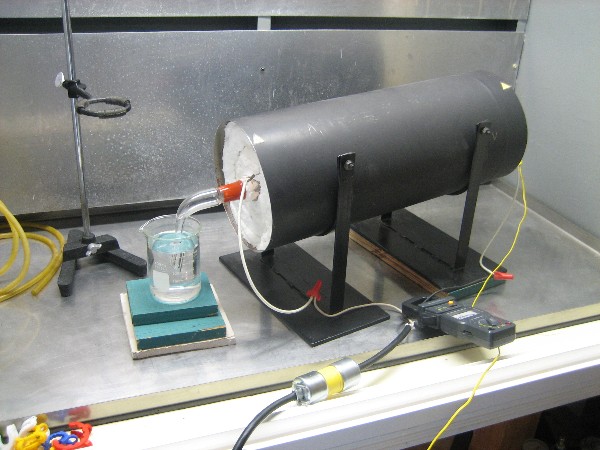 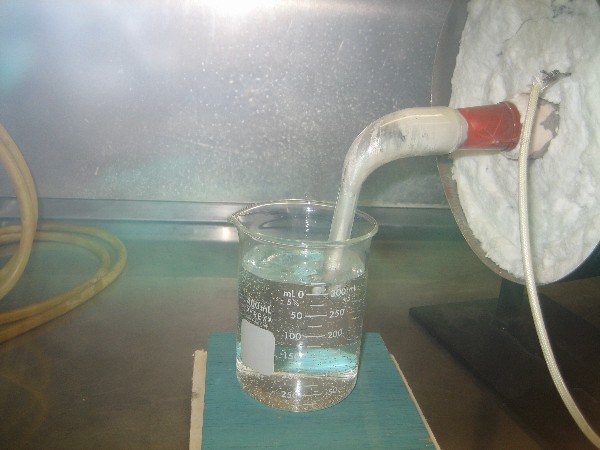 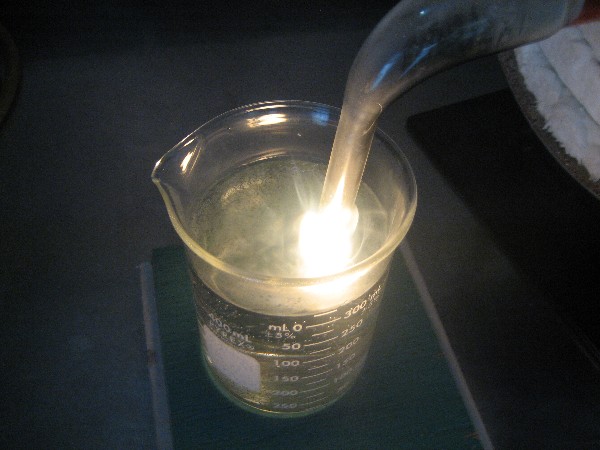 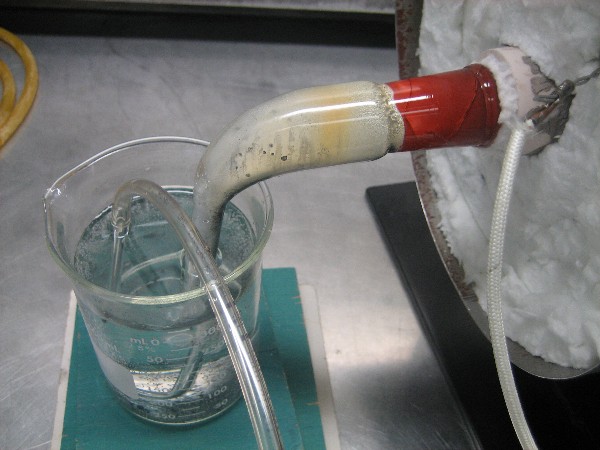
The single most important condition for a successful synthesis is good mixing - Nicodem
|
|
|
blogfast25
International Hazard
    
Posts: 10562
Registered: 3-2-2008
Location: Neverland
Member Is Offline
Mood: No Mood
|
|
Are you sure you saw phosphine (PH3 + P2H4) burning and not gaseous P? There's no source of hydrogen in your mix!
Also, you're not allowing for much cooling: gaseous P could be escaping from the adapter (through that 1 cm or so of water).
I would try this again but with silica present, as is done industrially with bone meal:
2 AlPO4 + 3 SiO2 --->Al2(SiO3)3 + P2O5
P2O5 + 5/2 C ---> 2P + 5/2 CO2
Making AlPO4 react with carbon without the 'silicating step' may prove very hard... Are you getting significant yield with AlPO4 alone, is the
question...
|
|
|
Magpie
lab constructor
    
Posts: 5939
Registered: 1-11-2003
Location: USA
Member Is Offline
Mood: Chemistry: the subtle science.
|
|
Quote: Originally posted by blogfast25  | Are you sure you saw phosphine (PH3 + P2H4) burning and not gaseous P? There's no source of hydrogen in your mix!
Also, you're not allowing for much cooling: gaseous P could be escaping from the adapter (through that 1 cm or so of water).
I would try this again but with silica present, as is done industrially with bone meal:
2 AlPO4 + 3 SiO2 --->Al2(SiO3)3 + P2O5
P2O5 + 5/2 C ---> 2P + 5/2 CO2
Making AlPO4 react with carbon without the 'silicating step' may prove very hard... Are you getting significant yield with AlPO4 alone, is the
question...
|
>There was apparently quite some H2O in the mix as evidenced by the significant condensate forming in the adaptor and the large amount of
phosphine. If the gas was P4 I believe it would have just settled to the bottom of the receiver as white P.
> Back about one inch from the end of the adaptor flange you can touch the adaptor with your hand --it's not hot at all.
>I do plan to try the well known industrial reactants for making P. I will substitute pottery grade Ca3(PO4)2 for apatite, however:
Ca3(PO4)2 + 8C + 3SiO2 ----> 3CaSiO2 + 8CO + 2P
>I don't think I got a good yield of P. I did get a lot of phosphine. However, this likely did not account for much consumption of P.
The single most important condition for a successful synthesis is good mixing - Nicodem
|
|
|
| Pages:
1
..
17
18
19
20
21
..
60 |